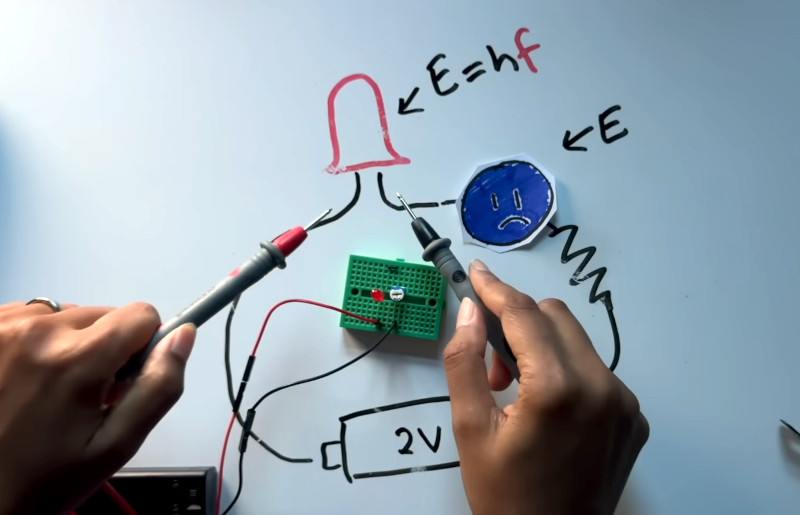We aren’t sure if [Looking Glass Universe] didn’t trust the accepted number for Planck’s constant, or just wanted the experience of measuring it herself. Either way, she took some LEDs and worked out the correct figure. Apparently, it hasn’t changed since we first measured it in 1916. But it’s always good to check.
The constant, if you need a refresher, helps explain things like why the color of light changes how the photoelectric effect manifests, and is at the root of quantum physics. LEDs are perfect for this experiment because, of course, they come in different colors. You essentially use a pot to tune down the LED until it just reaches the point where it is dark. Presuming you know the wavelength of the LED, you can estimate Planck’s constant from that and the voltage across the virtually ready-to-light LED. We might have used the potentiometer in a voltage divider configuration, but it should work either way.
The experiment showed that even a disconnected LED emits a few stray photons. But it was still possible to interpret the results. The constant is very tiny, so you’ll want your scientific calculator get do the math or, as she used, Wolfram Alpha.
The first result was off by the alarming amount of 1 x 10-40. No, that’s not alarming at all. That number is amazingly small.
This is a fairly common home physics experiment. You can do it quick, like [Looking Glass] did, or you can build something elaborate.
















I would suggest that only the “pure” colour LEDs work for this, the ones which use phosphors probably aren’t going to give good results
Happy to be told why I’m wrong though?
It’s true that the wavelength of the LED they use to activate the phosphor is probably not well-documented, so you’ll have difficulty using this to verify h.
But you could assume h and use the same math to figure out what the wavelength of the LED under the phosphor is
The trick of these physics experiments (we did this in school) is that you just want the ballpark.
The forward drop will always be around 2v, and the frequency will always be order of 5×10^14 Hz, the electron volt is 1.6×10^-19 joules.
The calculation is measured voltage × electron volt / frequency
So it will always be of the order 10^-34
2volts × 1.6e-19 is 3.2e-19
3.2e-19/5e14 = 6.4e-34
So I just “experimentally verified” planks constant to within 5% with mental arithmetic alone…
It’s not just a common experiment that has been reported on HAD already (https://hackaday.com/2021/06/28/measuring-plancks-constant-with-leds-and-a-dmm), the maker of this specific video here even gets several things wrong.
“Apparently, it hasn’t changed since we first measured it in 1916. But it’s always good to check.”
I know this is written in jest, but I’m not sure how I’d feel about a universe in which the value fluctuated 🙂
“…scattered showers, with occasional thunder. In other news, today’s value of Planck’s Variable is 47. And this week’s lottery numbers are exactly the same as they have been for the last ten years. Honestly, in what world would they be different each week? That would be a world gone mad and make a mockery of the whole thing. Now here’s Lisa with the sports news…”
I don’t think we’d be around to talk a out it if h got altered; it would fundamentally upend physics as we know it, and complex life would cease to function, just from altered protein folding alone; stars would fuse differently, it would be a bad day.
Reminds me of the old New Zealand film “The Quiet Earth”, in which if I remember it correctly (it’s been 40 years) a physicist’s experiment changes the value of the elementary electron charge, and weird things happen!
I doubt that the LED not fully turning off is due to thermal noise. My guess is, that the LED’s wires act as antenna and pick up RF, for example from her lapel microphone.
Ah never mind, someone in the YouTube comments has a better explanation. The issue is that there’s always some current flowing through the LED, even with a 1 M resistor. A voltage divider that sets the voltage for the LED would have avoided the problem.
She did use a potential divider (the DMM forming half at say 10M ohm).
Which one? There’s a lot of them, “Planck Units”…
Only one of which is Planck’s constant.